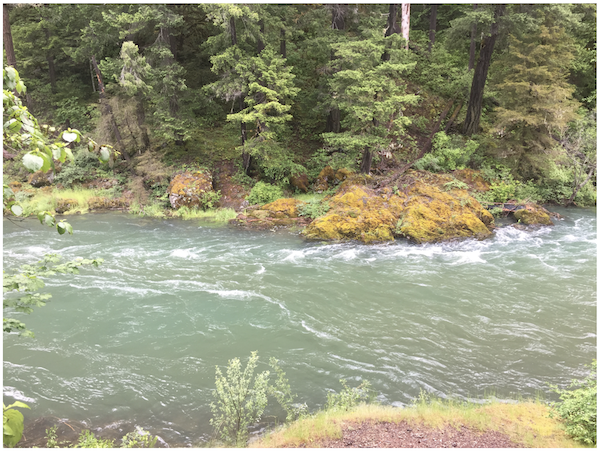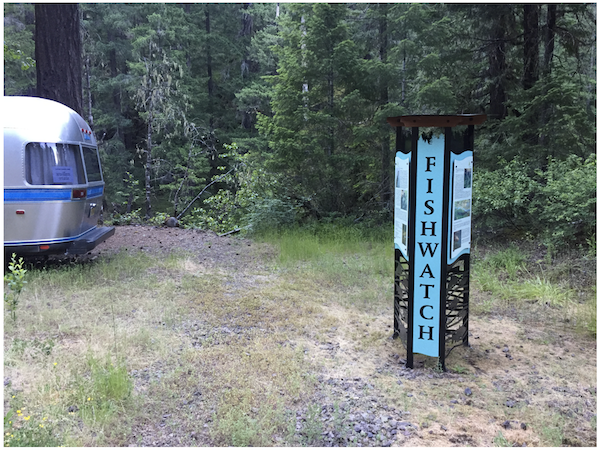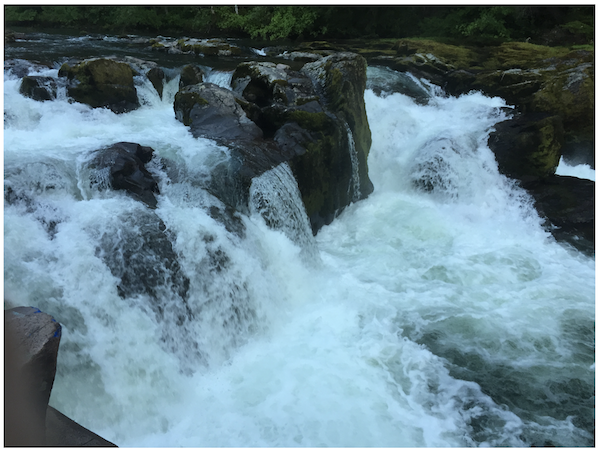FISHWATCH 2022 MONTHLY REPORT
June 2022
by Edward Kikumoto
COVID19 STATUS – The Big Bend Pool is open to the public this year until further notice to the contrary.
Compliance with CDC guidelines are recommended, especially for those who are unvaccinated and have underlying health concerns.
The FishWatch Caretaker is “social distancing,” and his happy to speak with you…just at a distance.
THE FISHWATCH MISSION
1) Deter poaching of the steelhead in the Big Bend Pool.
2) Keep human disturbance of the steelhead in the Pool to a minimum.
3) Educate the public about the Pool and its wild summer steelhead.
DISCLAIMER
The opinions in this report are strictly my own, and do not reflect the views and opinions of the U.S. Forest Service, the Oregon Department of Fish & Wildlife, or The North Umpqua Foundation.
Greetings from the Big Bend Pool,
OVERVIEW
I have not observed any illegal, unlawful or unacceptable behavior at the Pool during this period.
There were 64 visitors to the Pool while I was there.
As of this reporting period, I have not seen a steelhead or any steelhead activity in the Pool. However, I received a report on June 28 that about six steelhead were observed in Steamboat Creek below the Big Bend Pool, but above Little Falls (0.75 miles upstream from the Canton Creek Bridge). I was able to confirm that report myself, on the following day, when I saw about 10 to 12 steelhead holding in a pool below the Big Bend Pool.
BIG BEND POOL
Higher than normal water flows continued from May into June.
On June 13 heavy rains caused the USGS Water Gauge (the gauge) at CantonCreek Campground, which measures water flow volume, to reach 3,000 cfs (cubic feet per second).

Big Bend Pool on June 13 after extremely heavy rain.
On June 19 the late spring rains stopped, and the water volume started dropping every day towards 300 cfs. 300 cfs is noteworthy because it is hypothesized that the summer steelhead cannot or will not cross Little Falls until the water volume at the gauge drops below 300 cfs (200 to 300 cfs). This would partially explain why the wild summer steelhead have yet to arrive at the Big Bend Pool.
It is interesting to note that on June 26, the gauge measured 325 cfs, and two days later, 276 cfs, and that the first steelhead were seen in Steamboat Creek above Little Falls and below Big Bend Pool on June 28. Mere coincidence?
The other part of the hypothesis is that the volume of spring run-off this year and the late winter early spring rains have kept the mainstem rivers (Umpqua and North Umpqua Rivers) high and much cooler than in the recent past, and therefore, the steelhead don’t need to seek thermal sanctuaries so early this year. Keep in mind that the current Pacific Northwest drought has been going on since 2015. So this year’s wet spring may be affecting steelhead behavior in ways that we haven’t seen in a long time.
On July 1, the Oregon Department of Fish and Wildlife (ODFW) reported in a News Release, that 544 wild summer steelhead had crossed Winchester Dam by June 21, which already exceeds the reported total return of 450 wild summer steelhead last year. Of the 450 steelhead in 2021, 55 were observed in the Big Bend Pool.
We had our first 3-day heat-wave from June 25 thru 27.
06.25.22 Saturday high air temperature 100.
06.26.22 Sunday high air temperature 104, and 101 inside the Airstream. 06.27.22 Monday high air temperature 99.
The water temperature readings on June 27, Monday @ 18:45 were – Big Bend Creek (BBC) 58/60
Steamboat Creek above BBC 65/67
Bottom of Big Bend Pool 62/64
The higher than normal high water temperature in Big Bend Creek is probably due to the much higher volume of run-off coming from Homestead Creek and Big Bend Creek, which is diluting the cold spring water that originates in Bulldog Creek. In late summer the spring water coming from Bulldog Creek comprises most of the flow out of Big Bend Creek and will keep Big Bend Creek colder than now, under normal summer conditions.
WILDLIFE
On June 28 I saw an otter upstream of the Pool while I was taking water temperatures. The same day, visitors to the Pool saw an otter and 2 pups (or kittens) in the Pool, as well as an osprey that flew over. I told them mom otter was teaching her babies how to hunt crawdads.
On June 29 I saw a beaver cruising the pool in the late afternoon. The first of the season, and ditto for the otter.
Normally the otters and beavers don’t bother the steelhead in the Pool. Beaver babies are “kits.” Mergansers, on the other hand, particularly mom’s with young will dive on the steelhead – it looks intentional.
INFRASTRUCTURE
Satellite-phone purchased on June 20, along with a prepaid SIM card for 200-minutes and good for six months from activation. It will be necessary to purchase a new prepaid SIM card every year, which will cost approximately $500. The phone is not activated yet since it’s taking me sometime to figure out how to activate as well as set it up. The user manual is 235 pages!
I installed a 12-volt DC refrigerator ventilation fan to help move the air behind the refrigerator, in order to help it cool during extremely hot periods of the summer. It is an additional daytime draw on the batteries, which will mean more generator time at night in order to maintain the charge in the batteries.
On June 24, Karl Alleger helped me bring the kiosk frame up to the Pool. And on the following day I completed its installation.

FishWatch Kiosk installed.
I am using the Honda EU2200i generator almost every night for 2 to 4- hours to maintain the four 6-volt golf cart batteries. I’m considering doing a propane conversion on it because the propane runs cleaner, is less expensive than the non-ethanol gas I’m currently using, and I won’t have to deal with open containers of gas.
Southern Septic Service comes by to clean the toilets on the second Friday of the month. The maintenance person is extremely thorough in his cleaning, both inside and the exterior of the toilets. He actually washes down the outside of the toilets and scrubs them! I am impressed, if not in awe of his diligence, and the cleanliness of the toilets once he’s done.
Toilet use by the public was very light this month. Very few campers took advantage of them, which may mean that there were fewer campers than in previous years, possibly because of the cooler temperatures, including too cold creek temperatures for swimming.
After some thought I decided to not keep one toilet for my exclusive use. It didn’t seem fair, especially if the other toilet is heavily used.
Water temperature readings:
BBC – Big Bend Creek
BBP – Big Bend Pool
SC – Steamboat Creek
06.01.22 Wednesday @ 13:40
High air temperature 75.
BBC 46/48.
SC above BBC 50/52.
Bottom of BBP 48/51
06.20.22 Monday @ 12:20
High air temperature 80.
BBC 46/48
SC above BBC 48/51
Bottom of BBP 48/50
06.27.22 Monday @ 18:45 POST HEATWAVE
06.25.22 Saturday high air temperature 100.
06.26.22 Sunday high air temperature 102.
06.27.22 Monday high air temperature 99.
BBC 58/60
SC above BBC 65/67
Bottom of BBP 62/64
USGS Water Flow Gauge at Canton Creek Campground
(Canton Creek & Steamboat Creek combined flow.)
06.02.22 Thursday
879 cfs @ 13:30
06.04.22 Saturday
813 cfs @ 20:30
06.05.22 Sunday
1890 cfs @ 19:30
06.09.22 Thursday
684 cfs @ 19:30
06.11.22 Saturday RAIN
861 cfs @ 10:30
2860 cfs @ 17:30
06.13.22 Monday
2915 cfs @ 15:30
06.14.22 Tuesday
1800 cfs @ 18:30
06.16.22 Thursday
1020 cfs @ 12:30
06.19.22 Sunday SPRING RAINS OVER
06.20.22 Monday
591 cfs @ 14:30
06.21.22 Tuesday
529 cfs @ 09:30
06.23.22 Thursday
410 cfs @ 19:30
06.26.22 Sunday
325 cfs @ 17:30
06.28.22 Tuesday
276 cfs @ 09:30
06.30.22 Thursday
243 cfs @ 18:30
BIG BEND POOL FIELD NOTES
The USGS water flow gauge at the Canton Creek Campground.
The gauge measures the combined flows from Steamboat Creek and Canton Creek. Informed opinion is that 60% of the flow comes from Steamboat Creek, and the other 40% comes from Canton Creek. The easiest way to deal with it is to split the gauge flow in half between the two creeks.
Keeping that distinction in mind, all our reporting (anecdotal and scientific) uses the gauge flow measurement in reporting (because its actual and not a guesstimate), which can be a bit misleading especially when mentioning extreme highs (high, but not as high) and extreme lows (even lower).
For example, in the spring of 2019 the gauge reached 10,000 cfs. The heavy flow scoured the bottom and destroyed the year’s just hatched steelhead (alevin). The gravels that the alevin were hatched out of and initially live in for protection, was swept away, killing them. 10,000 cfs is a lot of water, but in reality Steamboat Creek was running at 5,000 to 6,000 cfs, still a lot of water but nevertheless a bit misleading if you actually want to know how high a flow it actually takes to scour the bottom, let’s say, in another watershed that has similar conditions.
200 to 300 cfs (cubic feet per second) at Little Falls.
There is research being conducted on how much water flowing over Little Falls will stop steelhead from jumping the falls. Too little water, and its too high to jump. Too much water and the speed and turbulence make it impossible to jump. It’s much more complicated than this, but… In this instance the concern is too high volume in the spring.
Little Falls is 3/4 miles upstream on Steamboat Creek from the Canton Creek Bridge. Little Falls is one of two barriers (the other is Steamboat Creek Falls, which is 5-miles upstream where there is a fish ladder) to steelhead moving up Steamboat Creek to eventually reach the Big Bend Pool and spawning areas further upstream.
A hypothesis is that the flow at Little Falls has to drop to 200 to 300 cfs (at the gauge) before steelhead can jump it. Much more research has to be done in the spring and fall before a more definitive statement can be made. In last week of June the flow at the gauge dropped below 300 cfs for the first time this spring and, lo and behold, steelhead started showing up just downstream from the Big Bend Pool, giving the hypothesis some credence.
And as I write this report in July, as the flow volume continues to drop, the number of steelhead in the pool is slowly going up.

Little Falls on May 26, 483 cfs at the gauge.
Early summer – green and murky water.
A steelhead in the green and murky water of early and mid-summer is very difficult to “see,” even if the water level is low, because its coloration is similar to its background, especially when it is overcast and there is little reflected light to create fish shadows or reflections of light from its movement. The easiest part of the steelhead to see under these conditions is its tail, which appears almost black and creates a distinctive dark vertical line in the water that is ever so slightly moving back and forth as the steelhead holds its position in the current. It’s lighter body color may then become discernible against the slightly darker greenish-brown background. Using binoculars, under these conditions helps. Often under these murky green conditions I’m just looking for movement or “steelhead activity.”
Steelhead activity.
“Steelhead activity” means movement by a steelhead that would clearly “show” its presence. These very distinctive movements are described as yawning, jumping or splashing, flashing, streaking, circling or re-positioning, and daisy-chaining.
Subtle movement is opening and closing its mouth, which appears momentarily white (the inside of the lower jaw of a steelhead is white, whereas, Chinook and Coho salmon have black lower jaws), and movement of its tail, as the edge of its tail is a distinctive vertical line, moving back and forth. With much concentration, its elliptical body shape (lighter in color) will gradually appear ahead of its tail. A steelhead may “shudder” as it opens and closes its mouth, and can be described as “yawning.”
Looking for tail movement or the distinctive dark triangular shape of the tail, is also a way to distinguish the steelhead from its shadow cast on the bottom. There’s only one fish there, not two.
Jumping can be a head to tail roll (fast or slow) or a somewhat out of control vertical leap into the air with a big splash at the end (similar to a human belly-flop). A splash can be a fast move up to the surface without the steelhead reaching the surface so that the water movement makes a splash, or when a steelhead will rise quickly to the surface, turn just below the surface and appear to slap its tail on the surface – you have to be watching carefully to see which it is.
Streaking is a momentary sudden burst of speed up or down stream.
Circling and re-positioning. Steelhead will occasionally circle the pool, although less often and more infrequently than salmon. A steelhead that continues to circle the pool may be injured. When they do circle it is often “circling back” to reposition themselves in the pool. As the steelhead hold in the pool, they actually creep forward slowly. At a specific point in the pool depending on a number of factors, they will circle back to where they started.
A steelhead may “flash,” in a singular movement that is part of making a tight circle near the bottom, as it turns on its side. Sunlight reflects off of its silvery side in a “flash.” A steelhead also turns on its side to create a redd – turning on its side and beating its tail on the gravel bottom to dislodge and move gravel to create a depression for depositing eggs, or filling the depression once eggs are deposited.
Daisy-chaining is when the steelhead will swim in a tight circle quite rapidly (aka, nervously). A daisy-chain circle is when the fish are head to tail to each other. This occurs in the very bottom of the Big Bend Pool. They will periodically break out of the circle and swim up the pool as a strung-out- group and then return to daisy-chaining. I would describe the movement as “agitated.” It is believed that this is an extreme stress response – in my experience, triggered by an unknown scent in the water. A person wading or sticking their hand in Big Bend Creek just upstream from the pool will trigger this response. Interesting enough, when a ODFW diver in a full wetsuit goes into the pool to count the fish and check on their general health the steelhead do not daisy-chain, although they will bunch up and keep their distance from the diver. And when the diver gets too close they will move away from the diver to a location in the pool the furthest distance from the diver. They move quickly but it does not look like a panicked response. Beavers, otters, and mergansers in the pool, as well as bald eagles, osprey and herons flying overhead do not cause the steelhead to daisy-chain.
Later in the summer the water becomes “crystal clear.” It’s like looking into a swimming pool. I don’t understand what changes for this to happen. Could it simply be run-off in the spring and early summer, and extremely low flows in mid to late summer?
END OF JUNE 2022 REPORT
Respectfully submitted,
Ed Kikumoto
FishWatch 2022 Caretaker
